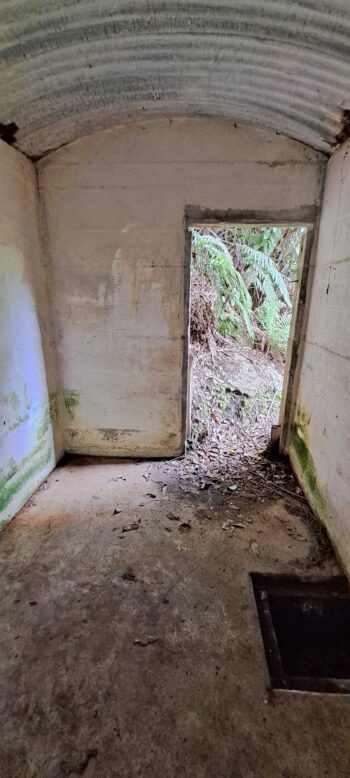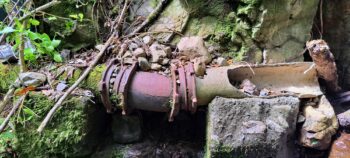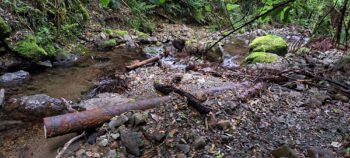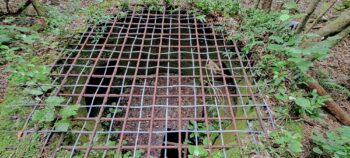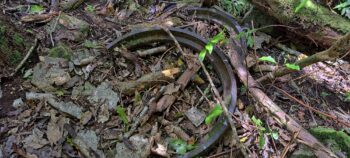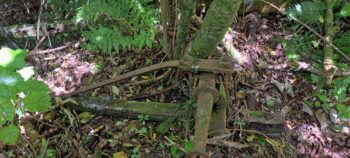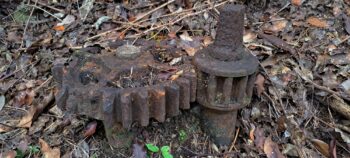Wainuiomata harbours remnants from a bygone era that are hidden away in the bush and known by few.
Wainuiomata boasts a rich history rooted in forestry, farming, and water management. This heritage is evidenced by a variety of relics scattered throughout the area. Some of these artifacts are prominently displayed and even marked with signs, while others can only be visited with guided tours. Yet, there are numerous hidden sites and artifacts that remain largely unknown.
Many of these historical sites were once in plain sight but have since been reclaimed by nature and concealed over time. The whereabouts of these hidden sites and relics are preserved in the memories of a select few who grew up in Wainuiomata during the mid to late twentieth century. Such hold valuable knowledge of these lesser-known aspects of Wainuiomata’s history.
Below is a non-exhaustive list of artefacts and sites that are largely hidden from public view.
Kittyhawk Plane Wreckage
 During WWII, a Kittyhawk aircraft en route from Baring Head to Palliser Bay detoured into Wainuiomata. While attempting to ascend a ridge behind Skerretts Creek, it encountered a downdraft, resulting in a crash that claimed the pilot’s life. The wreckage was left on the hillside, but over the years, various parts were removed. Nonetheless, some of the heavier components remain at the site.
During WWII, a Kittyhawk aircraft en route from Baring Head to Palliser Bay detoured into Wainuiomata. While attempting to ascend a ridge behind Skerretts Creek, it encountered a downdraft, resulting in a crash that claimed the pilot’s life. The wreckage was left on the hillside, but over the years, various parts were removed. Nonetheless, some of the heavier components remain at the site.
Water Race
 The Wainuiomata Water Race, constructed in the 1880s, was a vital infrastructure project designed to supply water to Wellington. Built to channel water from the Wainuiomata River, the race ran for about 2 km from the old dam to Coleman’s Tunnel.
The Wainuiomata Water Race, constructed in the 1880s, was a vital infrastructure project designed to supply water to Wellington. Built to channel water from the Wainuiomata River, the race ran for about 2 km from the old dam to Coleman’s Tunnel.
Colemans Tunnel
 Constructed during the 1880s, this underground shaft and tunnel in Wainuiomata was abandoned in 1899 and remains hidden from public view beneath the forest canopy. The location is known by few people and there is no actual track or path to the site.
Constructed during the 1880s, this underground shaft and tunnel in Wainuiomata was abandoned in 1899 and remains hidden from public view beneath the forest canopy. The location is known by few people and there is no actual track or path to the site.
Meter House
 This aged concrete hut stands beside a track that previously ran above Reservoir Road. It was constructed sometime between 1901 and 1903. The old water race runs beneath the building and it once housed a water meter. The site is now hidden in dense bush and its exact location is known by a few.
This aged concrete hut stands beside a track that previously ran above Reservoir Road. It was constructed sometime between 1901 and 1903. The old water race runs beneath the building and it once housed a water meter. The site is now hidden in dense bush and its exact location is known by a few.
Scour Pipe
 The scour pipe is concealed in the bush and can easily be mistaken for a tree trunk from a distance. Although its exact function is unclear, it appears connected to the Lower Dam system, indicating its age. The pipe likely served to drain debris and dirt from the water, especially during floods.
The scour pipe is concealed in the bush and can easily be mistaken for a tree trunk from a distance. Although its exact function is unclear, it appears connected to the Lower Dam system, indicating its age. The pipe likely served to drain debris and dirt from the water, especially during floods.
Earth Bridge
 This concealed embankment was part of Maintenance Road, an old road / track that runs parallel to Reservoir Road. It was constructed to allow vehicles to pass above the buried water pipes beneath. Beneath the bridge, a drainage pipe emerges through a brick-faced outlet.
This concealed embankment was part of Maintenance Road, an old road / track that runs parallel to Reservoir Road. It was constructed to allow vehicles to pass above the buried water pipes beneath. Beneath the bridge, a drainage pipe emerges through a brick-faced outlet.
Concrete Artefact
 This artefact may date back to the early 1880s. It consists of a buried concrete block with an iron door featuring a keyhole. The door bears an embossed logo surrounding the letters “W W,” which likely stand for Water Works, Wellington Water, or a similar designation.
This artefact may date back to the early 1880s. It consists of a buried concrete block with an iron door featuring a keyhole. The door bears an embossed logo surrounding the letters “W W,” which likely stand for Water Works, Wellington Water, or a similar designation.
Old Power Generator Site
 This location is believed to have once hosted a power generator supporting the construction of the Morton Dam. Evidence, including a water pipe, suggests the system utilised water pressure to operate a turbine, serving as an essential source of electricity during the dam’s development.
This location is believed to have once hosted a power generator supporting the construction of the Morton Dam. Evidence, including a water pipe, suggests the system utilised water pressure to operate a turbine, serving as an essential source of electricity during the dam’s development.
Horse Powered Log Arch Cart
 An old log arch cart hidden in the bush of Reservoir Valley stands as a relic of the area’s history. It was likely used by the Sinclair family to transport logs to their sawmill. Later, it may have also been repurposed to carry pipes during the valley’s use as a water catchment.
An old log arch cart hidden in the bush of Reservoir Valley stands as a relic of the area’s history. It was likely used by the Sinclair family to transport logs to their sawmill. Later, it may have also been repurposed to carry pipes during the valley’s use as a water catchment.
Skerretts Creek Water Catchment
 Skerretts Creek water catchment houses many hidden or semi-hidden artefacts. If you follow the creek upstream from the top of Sunny Grove, keep your eyes open. There are old pipe lines and broken pipes in the creek and along the banks. Other artifacts include concrete water tanks and water intakes.
Skerretts Creek water catchment houses many hidden or semi-hidden artefacts. If you follow the creek upstream from the top of Sunny Grove, keep your eyes open. There are old pipe lines and broken pipes in the creek and along the banks. Other artifacts include concrete water tanks and water intakes.
Mount Crowther Track Water Tanks
 Two water tanks lie partially hidden in the bush on the Mount Crowther Track near the top of Sunny Grove. It is not exactly clear where the water came from to fill the tanks and to where it went. The water could have come from the Skerretts Creek Water Catchment area.
Two water tanks lie partially hidden in the bush on the Mount Crowther Track near the top of Sunny Grove. It is not exactly clear where the water came from to fill the tanks and to where it went. The water could have come from the Skerretts Creek Water Catchment area.
Pearson Hut / Scout Hut
 Pearson / Scout was built in 1912, succumbed to fire in 1995. Today the site is unknown by most, but the existence of an abandoned fence and a chimney / fireplace locates the site where the hut once stood.
Pearson / Scout was built in 1912, succumbed to fire in 1995. Today the site is unknown by most, but the existence of an abandoned fence and a chimney / fireplace locates the site where the hut once stood.
Workers Huts
 There were once four huts in an area called the Terrace. One was Mackay Cottage and the other Pearson Hut. There are however two other huts that disappeared by the 1930s, but there are still remains to this day.
There were once four huts in an area called the Terrace. One was Mackay Cottage and the other Pearson Hut. There are however two other huts that disappeared by the 1930s, but there are still remains to this day.
The Black House
 The Black House was a hunters hut that predates housing in eastern Homedale. The hut succumbed to a fire, and was subsequently forgotten about with the bush reclaiming the site. However, remnants of the hut and some contents still remain.
The Black House was a hunters hut that predates housing in eastern Homedale. The hut succumbed to a fire, and was subsequently forgotten about with the bush reclaiming the site. However, remnants of the hut and some contents still remain.
Waiwhetu Tunnel
 The Waiwhetu Tunnel, built in the late 19th century, was part of Wellington’s early water supply system, designed to transport water from the Wainuiomata River to the city. Constructed with brick lining, the tunnel helped channel water through the hills to Seaview.
The Waiwhetu Tunnel, built in the late 19th century, was part of Wellington’s early water supply system, designed to transport water from the Wainuiomata River to the city. Constructed with brick lining, the tunnel helped channel water through the hills to Seaview.
Wainuiomata Tunnel
 Wainuiomata Tunnel, completed in 1915, is 3.2 km (2 miles) long and replaced the open-channel water race, ensuring a more reliable and protected water supply for Wellington. The Wainuiomata-side entrance has since been buried.
Wainuiomata Tunnel, completed in 1915, is 3.2 km (2 miles) long and replaced the open-channel water race, ensuring a more reliable and protected water supply for Wellington. The Wainuiomata-side entrance has since been buried.







